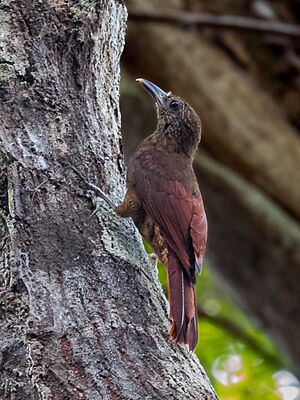Hoffmanns's woodcreeper facts for kids
Quick facts for kids Hoffmanns's woodcreeper |
|
|---|---|
 |
|
| Conservation status | |
| Scientific classification | |
| Genus: |
Dendrocolaptes
|
| Species: |
hoffmannsi
|
 |
|
The Hoffmanns's woodcreeper (Dendrocolaptes hoffmannsi) is a type of bird found only in Brazil. It belongs to the ovenbird family, Furnariidae. This bird is currently listed as a Vulnerable species, meaning its population is at risk.
Contents
About the Hoffmanns's Woodcreeper
Scientists classify the Hoffmanns's woodcreeper as a unique species. However, it is very closely related to other woodcreepers. These include the black-banded woodcreeper and the planalto woodcreeper. Some experts even think they might all be the same species.
What Does It Look Like?
The Hoffmanns's woodcreeper is a fairly large bird for its group. It has a slim body and a long tail. Its bill is straight and medium-sized. This bird is about 28 to 29 cm (11 to 11 in) long. Males usually weigh between 78.5 to 86 g (2.8 to 3.0 oz). Females are a bit lighter, weighing about 74 to 89 g (2.6 to 3.1 oz).
Both male and female birds look alike. Their faces are a dark, dull yellow-brown. They have a slightly scaly look and a faint stripe above their eyes. The top of their head is reddish. This color turns to a reddish-brown on their neck and back. The feathers on their head have black tips. Their lower back, wings, and tail are a reddish-brown color.
Their throat and belly are a dull yellow-brown with a hint of olive green. The belly becomes more yellowish. Their chest has faint, light streaks. The belly and sides of their body have faint, narrow dark bars. Their eyes can be light gray or brown. Their bill is usually dark gray to black, with a lighter lower part. Their legs and feet are gray. Young birds look similar to adults. However, they are more reddish on top and more yellowish below. They also have different amounts of bars and streaks on their undersides.
Where Does It Live?
The Hoffmanns's woodcreeper lives in the Amazon rainforest in Brazil. It is found south of the Amazon River. Its range is between the Rio Madeira and Rio Tapajós rivers. To the south, it reaches the states of Rondônia and Mato Grosso.
This bird prefers humid forests. It lives in both terra firme forests (forests on higher, dry ground) and várzea forests (forests that flood seasonally). It mostly stays deep inside primary forests, which are old-growth forests. But it can also be found at the edges of these forests. Sometimes, it lives in mature secondary forests, which are forests that have regrown after being disturbed.
Behavior and Habits
Movement
The Hoffmanns's woodcreeper stays in its home area all year round. It does not migrate.
Feeding Habits
Scientists do not have a lot of information about what the Hoffmanns's woodcreeper eats. However, they believe it mainly eats arthropods, like insects and spiders. This bird often follows swarms of army ants. It is thought to also join mixed-species feeding flocks, where different bird species feed together. It usually forages alone.
When it follows ant swarms, it perches on tree trunks that stand straight up. It stays within 2 m (7 ft) of the ground. From there, it quickly flies out to catch prey from plants. When it is not following ant swarms, it can forage much higher in the trees, sometimes up to the middle layer of the forest.
Reproduction
The Hoffmanns's woodcreeper seems to breed during the late dry season and early wet season. This is usually from September to November. Only one nest has ever been found. It was in a hole in a dead tree trunk. The nest was about 18 m (60 ft) above the ground. Not much else is known about how this species reproduces.
Vocalization
The Hoffmanns's woodcreeper mostly sings at dawn, which is early in the morning. It probably sings at dusk (evening) too. Its song is a fast, steady sound that goes "wutwutwut---". It can repeat this sound up to 20 times. Its other calls include sounds like "wh’kai", "kaihh-jeep", and snarling noises.
Conservation Status
The IUCN (International Union for Conservation of Nature) first listed the Hoffmanns's woodcreeper as "Least Concern." But since 2012, it has been listed as "Vulnerable." This means the species faces a high risk of becoming endangered in the wild.
The biggest threat to this bird is the fast rate of deforestation in its limited home range in the Amazon basin. Deforestation means cutting down forests. This bird is thought to be very sensitive to human activity. It is naturally rare and prefers old-growth forests. These factors make it especially vulnerable to threats. The region where it lives is not well-studied by bird experts. The Hoffmanns's woodcreeper is rarely seen and not much is known about it.


